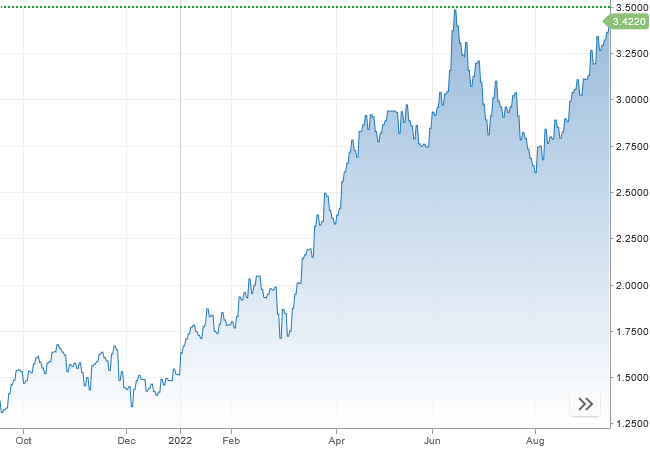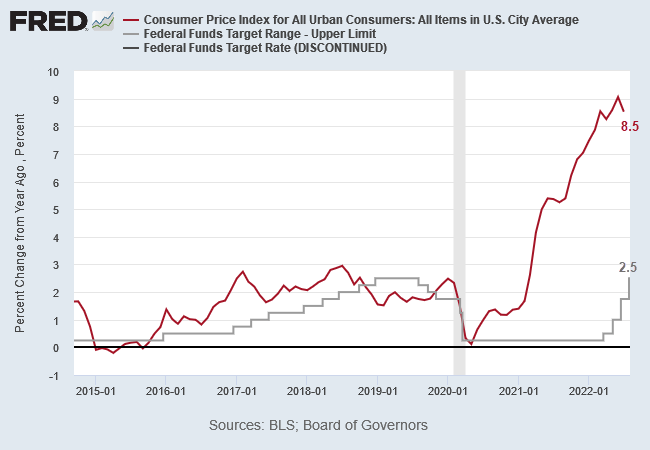Fed Chairman Jerome Powell declared that the Fed’s commitment to taming inflation is “unconditional”:
June 23 (Reuters) – The Federal Reserve’s commitment to reining in 40-year-high inflation is “unconditional,” Powell told lawmakers on Thursday, even as he acknowledged that sharply higher interest rates may push up unemployment.
“We really need to restore price stability … because without that we’re not going to be able to have a sustained period of maximum employment where the benefits are spread very widely,” the Fed Chairman told the U.S. House of Representatives Financial Services Committee.
Under questioning by members of the House panel on Thursday, Powell said there was a risk the Fed’s actions could lead to a rise in unemployment. “We don’t have precision tools,” he said, “so there is a risk that unemployment would move up, from what is historically a low level though. A labor market with 4.1% or 4.3% unemployment is still a very strong labor market.”
He also dismissed cutting interest rates if unemployment were to rise while inflation remained high. “We can’t fail on this: we really have to get inflation down to 2%,” he said.
The Fed chief was also asked about the central bank’s balance sheet, which was built up to around $9 trillion during the pandemic in an effort to ease financial conditions and is now being pared. The Fed aims to get it “roughly in the range of $2.5 or $3 trillion smaller than it is now,” Powell said.
But the bond market isn’t buying it. Treasury yields from 2-year to 30-year are compressed in a narrow band above 3%, indicating a flat yield curve. Expectations are that the Fed can’t go much higher than 3.0% to 3.5%.

The dot plot from the last FOMC meeting similarly projects a 3.4% fed funds rate by the end of 2022, 3.8% by 2023, and lower at 3.4% by the end of 2024.

You cannot cure inflation with a Fed funds rate (FFR) of 3.5%.
CPI is growing at 8.6% YoY, while the FFR target maximum is 1.75%. Another 1.75% just won’t cut it. You have to hike rates above inflation. Positive real interest rates are the best antidote for inflation but the economy, in its current precarious state, could not withstand this.

Taming inflation in the 1980s
Paul Volcker killed inflation by hiking the fed funds rate to 20% in 1980, but we live in a different world.
In 1980, federal debt to GDP was less than 50% of GDP. Today it’s 118%.

The Federal deficit was 2.5% of GDP. Now it’s 12%.

Private debt (excluding the financial sector) was 1.35 times GDP in 1980. Now it’s more than double.

Powell can’t hike rates like Volcker. If he tried, he would collapse the economy and the US Treasury would be forced to default on its debt. Collapse of the global reserve asset is about as close as you can get to financial Armageddon.
Pricking the bubble
Instead, the Fed plans to use QT to deflate the asset bubbles in stocks and housing, in the hope that a reverse wealth effect — as households feel poorer — will slow consumer spending and reduce inflation.
So far, the S&P 500 has dropped by 25% and the housing market is likely to follow. The 30-year mortgage rate has climbed to 5.81%, more than double the rate in August last year.

Housing starts and permits are both declining.

Powell talks of a $2.5 to $3.0 trillion reduction in the Fed’s balance sheet. That would increase the supply of Treasuries and MBS in financial markets by an equivalent amount which would be sucked out of the stock market, causing a fall in prices.
The two largest foreign investors in US Treasuries — Japan and China — have also both become net sellers to support their currencies against the rising Dollar. That will further increase the supply of Treasuries, causing an outflow from stocks.
Since 2009, stock market capitalization increased by $47.4 trillion, from $16.9T to $64.3T at the end of Q1. At the same time, the Fed’s balance sheet increased by $7.9 trillion, from $0.9T to $8.8T. Market cap increased by $6T for every $1T increase in the Fed’s balance sheet (QE). The multiplier effect is 6 times (47.4/7.9).

If the Fed were to shrink its balance sheet by $2.5 trillion and net foreign sales of Treasuries amount to another $0.5 trillion, we could expect a similar multiplier effect to cause an $18 trillion fall in market capitalization ($3Tx6). Market cap would fall to $50T or 26.5% from its $68T peak in Q4 of 2021.
That’s just the start.
“Inflation is always and everywhere a monetary phenomenon”
Nobel prize-winner Milton Friedman argued that long-term increases or decreases in the general price level were caused by changes in the supply of money and not by shortages or surpluses of oil, commodities or labor.
The chart below shows the supply of money (M2) as a percentage of GDP. The economy thrived with M2 below 50% throughout the Dotcom boom of the late 1990s but has since grown bloated with liquidity as the Fed tried to revive the economy from the massive supply shock of China’s admission to the World Trade Organization in 2002 — the introduction of hundreds of millions of workers earning roughly 1/30th of Western-level wages.

The massive supply shock helped to contain prices over the next two decades, perpetuating the myth of the Great Moderation — that the Fed had finally tamed inflation. Fed hubris led them to pursue easier monetary policy with little fear of inflationary consequences.
All illusions eventually come to an end, however, and the 2020 pandemic caused the Fed to purchase trillions of Dollars of securities to support massive government stimulus payments. The MMT experiment failed disastrously, causing a $5 trillion spike in M2 without an accompanying rise in GDP. M2 spiked up from an already bloated 70% of GDP to more than 90%, before GDP recovered slightly to reduce it to the current 89%.
Trade tensions with China, coupled with supply chain disruptions from the 2020 pandemic and a sharp rise in natural gas prices — as industry switched from coal to reduce CO2 emissions — triggered price increases. These were aggravated by Russia’s invasion of Ukraine and resulting sanctions, leading to oil shortages.
Normally, high prices are the cure for high prices. Consumers cut back purchases in response to high prices and demand falls to the point that it matches available supply. Prices then stabilize.
But consumers are sitting on a mountain of cash, as illustrated in the above M2 chart. They continued spending despite higher prices and demand didn’t fall. Investors who have access to cheap debt also, quite rationally, borrow to buy appreciating real assets. Unfortunately cheap leverage is seldom channeled into productive investment and instead fuels expanding asset bubbles in homes and equities.
The Fed is forced to intervene, employing demand destruction, through rate hikes and QT deflate asset bubbles, to reduce consumer spending.
An unwelcome side-effect of demand destruction is that it also destroys jobs. Unemployment rises and eventually the Fed is forced to relent.
Conclusion
Fed Chairman Jerome Powell says that the Fed’s commitment to reining in inflation is “unconditional” but the bond market is pricing in rate hikes peaking between 3.0% and 3.5%, way below the current rate of inflation. The economy is unlikely to be able to withstand more because of precarious levels of debt to GDP and a massive fiscal deficit.
Instead, the Fed plans to shrink their balance sheet by $2.3 to $3 trillion. QT is expected to deflate asset bubbles in stocks and housing and achieve a reverse wealth effect. Households are likely to curb spending as their net worth falls and they feel poorer.
Unfortunately, demand destruction from rate hikes and QT will also cause unemployment, inevitably leading to a recession. The Fed seems to think that the economy is resilient because unemployment is low and job openings outnumber unemployed workers by almost 2 to 1.

But elevated debt levels and rapidly rising credit spreads could precipitate a sharp deleveraging, with crumbling asset prices, rising layoffs and credit defaults.

The Fed may also manage to lower prices through demand destruction but inflation is likely to rear its head again when they start easing. Surging inflation is likely to repeat until the Fed addresses the underlying issue: an excessive supply of money.
Milton Friedman was a scholar of the Great Depression of the 1930s which he attributed to mistakes by the Fed:
“The Fed was largely responsible for converting what might have been a garden-variety recession, although perhaps a fairly severe one, into a major catastrophe. Instead of using its powers to offset the depression, it presided over a decline in the quantity of money by one-third from 1929 to 1933 … Far from the depression being a failure of the free-enterprise system, it was a tragic failure of government.”
Ben Bernanke, another scholar of the Great Depression, acknowledged this during his tenure as Fed Chairman:
“Let me end my talk by abusing slightly my status as an official representative of the Federal Reserve. I would like to say to Milton (Friedman) and Anna (Schwarz): Regarding the Great Depression, you’re right. We did it. We’re very sorry. But thanks to you, we won’t do it again.”
Instead the Fed made the opposite mistake. By almost doubling the quantity of money (M2) relative to GDP (output) they have created an entirely different kind of monster.

Slaying the beast of inflation is likely to prove just as difficult as ending the deflationary spiral of the 1930s.





























































 Click to play
Click to play






